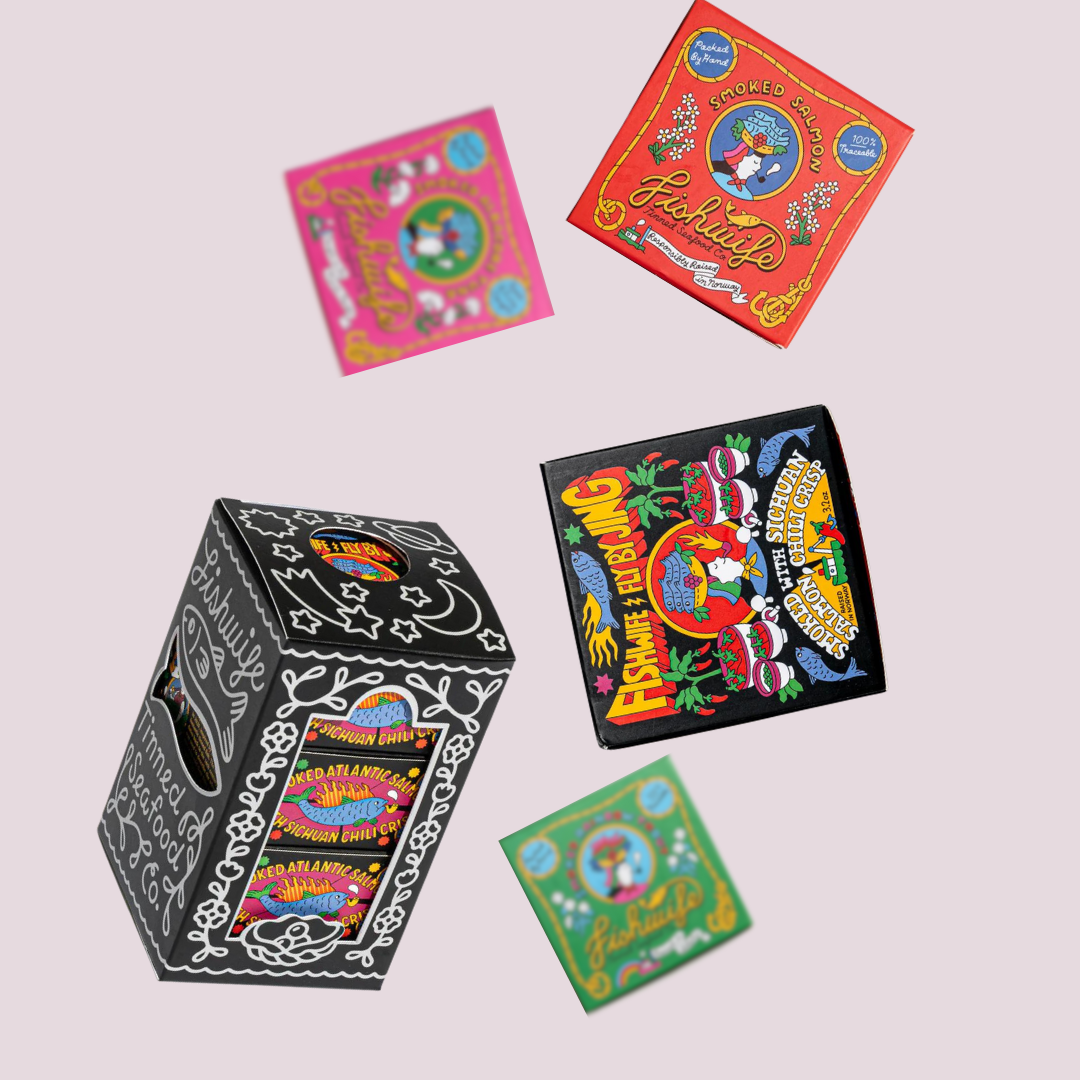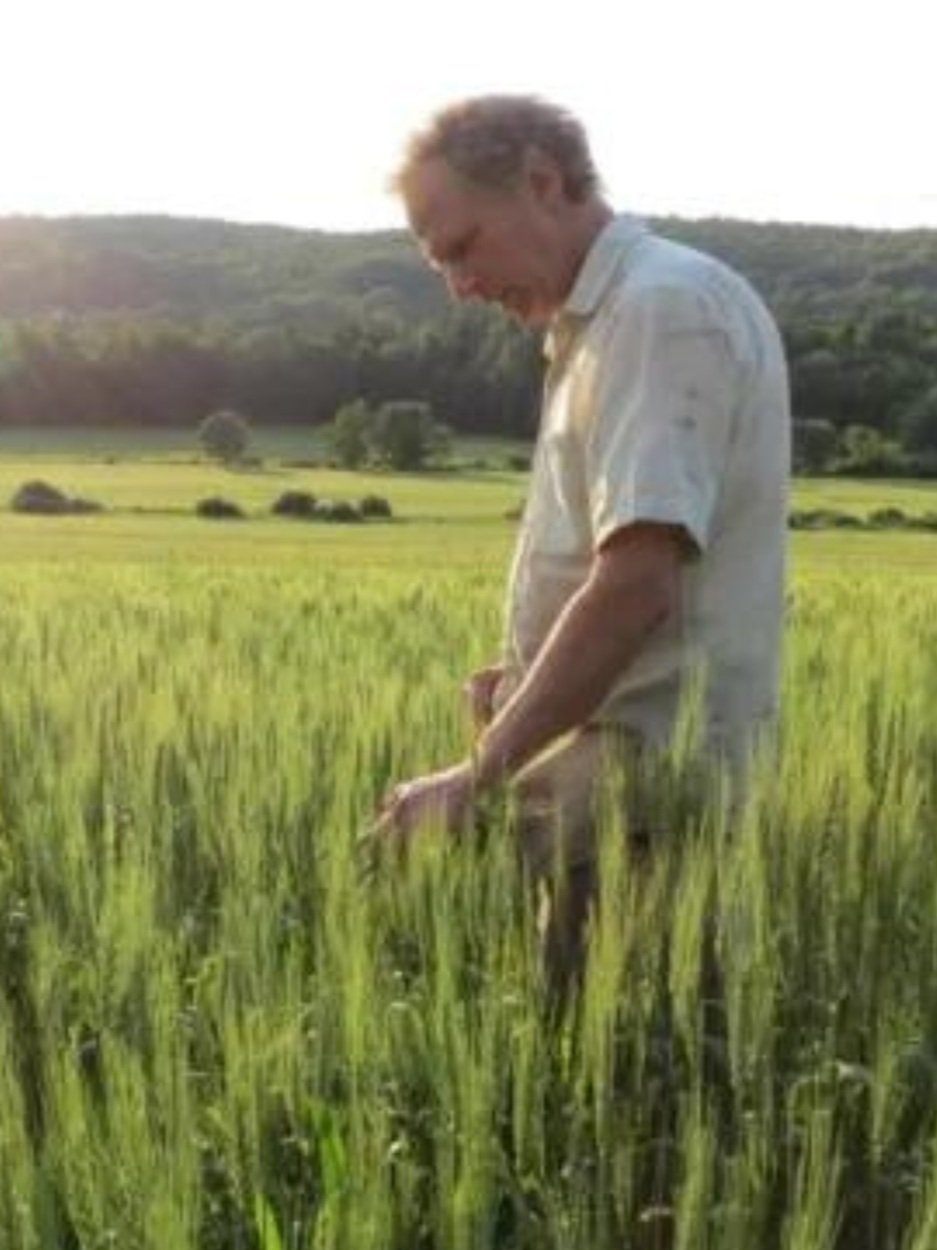Gone Fishing with Becca Millstein
Becca Millstein never intended to start a food business. She had been working in the music industry for three and a half years when COVID hit, forcing everyone to quarantine and develop new at-home habits. That was when one of her own pandemic-fueled routines—eating copious amounts of tinned fish—inspired a sudden realization that she simply couldn’t ignore.
This European delicacy was quickly becoming a staple for Becca’s friends and family, too—but there wasn’t an American premium tinned seafood brand to grow with the trend. So Becca felt she had no choice but to launch one herself. “It was a destiny moment,” she remembers. “Some of us experience those in life. I had no plans to start a food company, but I was like, ‘I must do this.’”
Nearly three years later, Fishwife is well on its way to becoming a household name. Its colorful tins of preserved treats like wild-caught smoked albacore tuna and Cantabrian anchovies are already incredibly popular among the Mast Market community, which appreciates the brand’s focus on fresh flavor and sustainable sourcing. And with Fishwife’s recent arrival at Whole Foods, it won’t be long before the rest of the country is on board.
Here, Becca shares the details behind the company’s quick ascent, the challenges she faced along the way, and where Fishwife is headed next.

Becca Millstein, founder and CEO of Fishwife
The following interview has been edited and condensed for clarity.
Mast Journal: Why exactly did you decide to leave the music industry to pursue a career in food?
Becca Millstein: I had just started working at a music startup before COVID hit. It was very IRL focused. It was basically WeWork for musicians. So when everything went remote, the core of the job kind of went away. But I'd had the chance to see what a startup was like. I'd never had proximity to entrepreneurship before. So, for the first time, starting my own business seemed like a possibility.
And during Covid, I was living with my friend Caroline and we were eating a massive amount of tinned fish. That’s the way people were eating at that time—trying not to go to the grocery store too often. It's one of the only shelf-stable, very nutritious, protein-rich foods, and it's also just easy to eat quickly between Zoom meetings. I just could sense that tinned fish was a moment that was about to happen.
MJ: But tinned fish was already a thing in other countries, right?
BM: Yes, definitely. I had been exposed to conservas—elevated, premium tinned seafood—when I lived in Spain in college. I traveled to Portugal and was like, ‘Oh my God, what is this world of fancy tinned fish? I've never seen anything like it.’ It has not, historically, had a presence in the U.S. People like Alison Roman, Anthony Bourdain, and David Chang, titans in the food industry, had started to spread the gospel about tinned fish amongst their community, but it wasn’t until COVID when I noticed on social media that friends of mine were eating tinned fish at home.
There was suddenly just that elevated, European, aspirational way of eating at home. There was a lot of latent and bubbling excitement. So when we had the lightbulb moment that there had been no innovation in the American tinned seafood category ever, I was just like, ‘I have to do this. I'm doing this. It's so obvious.’ And then we tried to get it out to market as quickly as possible.
MJ: And you launched Fishwife four months later?
BM: Yeah, we launched this beta program four months after we came up with the idea. So that was a little market test, essentially. And then we launched in seriousness at the beginning of December 2020.
MJ: Wow. How did you get the business off the ground?
BM: We just started building a supply chain in the U.S. We were also trying to build a supply chain in Spain, but it was definitely way harder during COVID to develop products internationally. So we got in touch with a cannery in Oregon through talking to a fisherman in California and developed products from there. Literally, this is how businesses start sometimes.
I also spent two or three months just talking to every entrepreneur that I knew. I talked to people in food and not, started getting my advisors, and built a very high-level business plan, which we've fully stuck to, which is kind of funny. But it's because the playbook is pretty firmly established at this point.
For a brand like ours, you launch direct-to-consumer, you build a base, you get data, you have this iterative product development process with your customers, you establish that, and then you start expanding to the specialty channel. That is a nice feedback loop of driving discovery, great marketing, and building your revenue. As of last year, we started expanding into grocery stores. That's the next phase and the future of the business in many ways.
MJ: How do you split your focus between specialty stores and bigger grocers?
BM: Thankfully, specialty stores don't require very much maintenance. We've set it up so it’s just plug and play at this point. The shops can order directly from us, and discovery has always been really great for us. We're out there in the world and people know about us, so we get a lot of inbound interest.
Scaling into national retail is just a whole other world. It’s way more expensive. Just imagine being in 500 Whole Foods across the country—the merchandising, the demos, the promos you have to pay for. You have to make sure your product is moving off the shelf. We are a super small team, so we're very focused on grocery now. We launched in Whole Foods at the beginning of this quarter and are about to expand quite a bit with that partner and then are working towards the national launch. That will be a very, very, very big moment for Fishwife. And I'm extremely excited about it. And it feels very close.
MJ: That's a huge hurdle to overcome and also a big way to get into all the homes of people that aren't necessarily shopping at shoppy shops.
BM: Exactly, exactly. And that expansion will come with a bunch of new products that are at a lower SRP—or a lower price point. They’re still very premium products, but not ultra premium like our products now.
MJ: On that note, what are the products you offer now? And what new products are you working on?
BM: We have this core set of smoked Atlantic salmon, smoked rainbow trout, smoked albacore tuna, and the Fly by Jing smoked salmon collaboration, which really just took off, so we decided to keep it around forever. We just launched Cantabrian anchovies in January, which are truly so good and so stunning and open up many new use cases for our customers because they are so great for cooking. And that's really exciting. That product is very, very emblematic of the direction we're going in, which is making really amazing, delicious premium products, but with canneries outside of the U.S., so we can hit a lower SRP. That's being sold at Whole Foods at $7.99. We're usually like $10.99 and above in all the shoppy shops.
MJ: Are there any specific types of fish that you're most excited about working with?
BM: Totally. We started working with a cannery in Spain on some sardines, but we discontinued them because we felt that we couldn't stand behind the fishery that we were sourcing from at the time. So we've taken a year to connect that cannery with a sustainable sardine fishery. We're really, really excited about that. Because it's pretty hard to find certifiably sustainable sardines.
MJ: The supply chain must be super complicated.
BM: Oh my God. Honestly, I don't want to say ‘you don't know the half of it,’ but it's insane. It's literally insane.
MJ: And after experiencing success with the Fly by Jing collaboration, are there other collaborations in the works with like-minded millennial founders?
BM: Last year, 2022, was the year of the Fishwife small batch collaboration. It was awesome. But it actually usually takes more effort than developing a scalable product and with obviously much less of a reward, since we're only making 25,000 units instead of 500,000 units. Right now, we are singularly focused on products that we're scaling into retail, and we'll start to explore doing collaborations once we've gotten all of our scalable retail products out to market. We’ll probably start looking at doing collaborations at the end of 2024, realistically.
MJ: With this scalable focus in mind, are you keeping your same branding or is there anything on the visual side that is changing?
BM: It's honestly just getting a lot better. Danny, our illustrator, and I still love our original packaging a lot, but with the new products we've been able to build from the ground up at the skill level that we have now. So the branding for the new products is the same, but a lot better, which I'm very excited to share.

MJ: Fishwife has a great aesthetic, with bold, primary colors and playful graphics. How did you originally decide on that look? And how did you name the company?
BM: We got the name the day after we decided to start the company. I called a friend and fellow entrepreneur, Grier Stockman, who runs a company called Block Shop, and she found the term ‘fishwife’ online, just Googling around. Once we locked in the name of the brand, we had a lot to work off of. I put together a mood board with a bunch of different references. They were all super vibrant and graphic, but also utilitarian and classic. Topo Chico and Café Bustelo were two of our biggest references.
MJ: And what does the term ‘fishwife’ mean?
BM: It is an old insult. It was originally used to describe the wives and daughters of fishermen, who would sell their husband’s or father's wares at the market. And because fish is fresh, fish is so perishable, they gained a reputation for being really loud and yelling and swearing. And so ‘fishwife,’ over time, turned into this gendered insult for a foul-mouthed woman. So it very much resonated with me.
MJ: That's a really fun way to nod to your role as a female founder, without subscribing to the old-school “girl boss” of it all.
BM: Exactly. That was the intention.
MJ: We love that. And what are your favorite ways to eat Fishwife? What is your ideal snack for aperitivo hour?
BM: I use Fishwife a lot for just quick, easy, delicious dinners. I will do a rice bowl with the Fly by Jing salmon, often with bok choy, nori, and sesame seeds. And a fried egg—that's so easy and delicious. Or I'll do a pasta with the tuna and some vegetables. Or I’ll cook tomato sauce with anchovies. I really do just love to eat it on a snack plate, too, especially if I have some friends over. I'll just get a baguette at the little Cookbook Market down the street. I'll also get some good butter, olive oil, olives, and then cut up some fruit. It's just super easy and very elegant.
MJ: And what drink do you pair with Fishwife?
BM: I just did a big tasting of some new smoked trout products we're developing, and we did it at a brewery. So we were drinking some really great beers alongside our smoked fish. And it was awesome. That is a very killer combo. I used to be a big wine and tinned fish girl, but I'm starting to subscribe to a light wheat beer with tinned fish. It's just a perfect complement.
More from The Journal

Growing Organic with Thor Oechsner
In conversation with local, organic grain farmer, Thor Oechsner.
Read more
Charley Cummings is Growing Change
In conversation with founder and CEO of Walden Mutual Bank, a digital bank built to support local and sustainable food systems of the northeast.
Read more